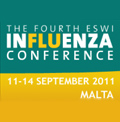 Issued at the end of a four-day conference on influenza organized by the European Scientific Working group on Influenza (ESWI) in Malta, the warning reflects a consensus that the emergence of a next worldwide outbreak of influenza is only a question of time.
Issued at the end of a four-day conference on influenza organized by the European Scientific Working group on Influenza (ESWI) in Malta, the warning reflects a consensus that the emergence of a next worldwide outbreak of influenza is only a question of time.
Predicting when a pandemic influenza virus will emerge is impossible, and although scientists consider the avian influenza H5N1 virus to be a possible source, numerous other candidate viruses also exist.
The avian influenza H5N1 virus recently showed up in poultry and wild birds in countries that had been disease-free for several years, such as Bulgaria, Romania and Israel. In addition, recent research indicates that H5N1 virus only needs a limited number of mutations to become transmissible from mammal to mammal.
Furthermore, a newly arisen H5N1 virus strain, that apparently escapes from existing poultry vaccines, is spreading in Asia and beyond. Together, these events signal the risk posed by H5N1 influenza, to animal and human health.
Yet, the past pandemic caused by a H1N1 virus has shown that preparedness should not only focus on H5N1 infections, but also on other influenza A virus subtypes. H1N1 influenza viruses continuously re-assort in pigs, and porcine H3N2 influenza viruses cross the species barrier to humans from time to time…
Influenza is a moving target, and one should expect the unexpected.
At the Fourth ESWI Influenza Conference, the 2009 H1N1 influenza pandemic was thoroughly evaluated in all of its aspects. Consensus exists that overall European countries managed the 2009 H1N1 pandemic crisis well.
Surveillance, mass vaccination campaigns and the use of antiviral drugs have collectively contributed to a reduced impact of a pandemic for the first time in human history.
Improvements, however, are to be made in light of the emergence of a future influenza pandemic. Heightened readiness is needed on a global scale. Global monitoring of human and animal influenza viruses must be improved to evaluate the spread of existing influenza viruses and to detect the appearance of new virus strains.
Pre-pandemic vaccines must be tested for effectiveness against the emerging mutant influenza virus strains. Also studies on the evolution of influenza viruses in humans and animals must be promoted to track the moving target.
Therefore, the Fourth ESWI Influenza Conference urged national and international authorities, academia and vaccine manufacturers to forge strong and effective collaborations to improve pandemic preparedness worldwide.
Routine vaccination of high risk groups against annual recurrent seasonal influenza is a pillar of pandemic preparedness. In this light, the World Health Organization has launched its seasonal flu vaccination recommendations also endorsed by the European Commission, urging Member States to annually immunise at least 75% of its senior citizens against influenza.
In 2011, few of the EU member states come close to achieving this recommended target, despite European health care systems being amongst the best in the world.
Discussions at the conference had been opened by John Dalli, European Commissioner for Health and Consumer Policy, who emphasized the importance of collaboration between science and policy. “We all share the same goal: to reduce the burden of influenza. To get there, we need to work together. Science has an important role to play. It is only by combining the latest scientific knowledge with effective policy planning, that we will succeed in addressing the disease,” Mr Dalli said.
This statement is at the heart of the Fourth ESWI Influenza Conference. Indeed, the conference gathered members of organisations of healthcare providers, senior citizens, at-risk patients and public health authorities in a separate programme track called the Science Policy Interface.
Remarkable examples of collaboration between various stakeholder groups and their positive impact on public health were presented and discussed, demonstrating the key importance of interacting with stakeholders and managing the dialogue.
ESWI will continue to work with all stakeholders on a daily basis. Only by bringing stakeholders together and facilitating interactions between them we can reduce the burden of influenza.
Prof. Dr. Ab Osterhaus is chiar of ESWI and chair of the Fourth ESWI Influenza Conference
Mrs. C. Vanlangendonck is a strategic communication consultant at ESWI
Related: Europe falling short of flu targets





VaccinesToday (@VaccinesToday) (@VaccinesToday) (@VaccinesToday)
September 23rd, 2011
Pandemic flu: ‘Expect the unexpected when hunting a moving target’ http://t.co/Om6yUE9d via @vaccinestoday @eswi2011